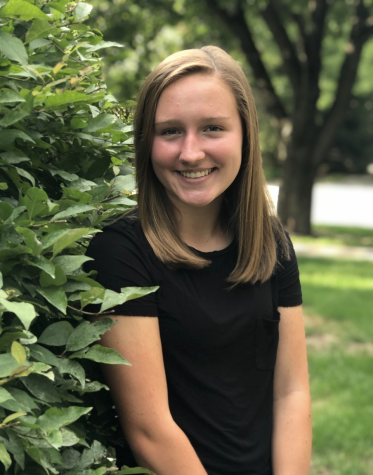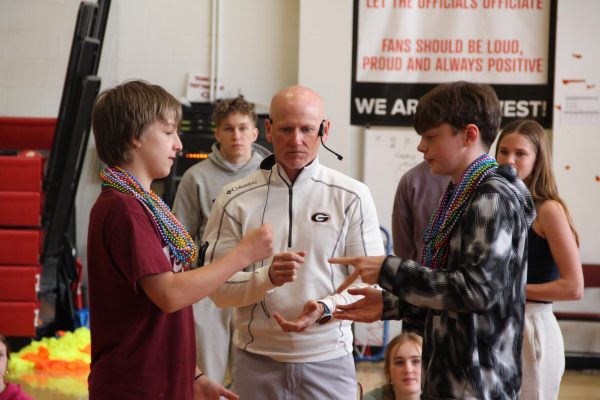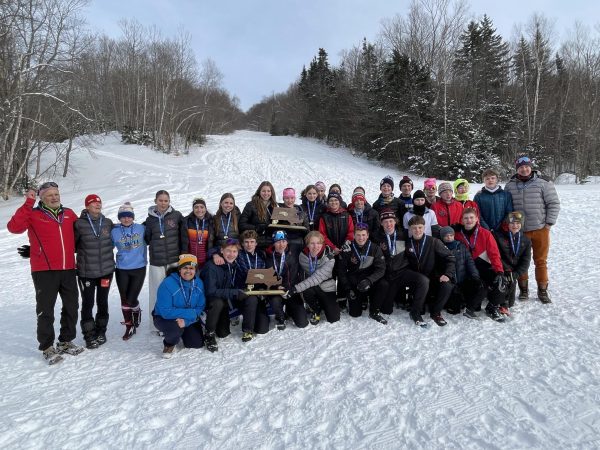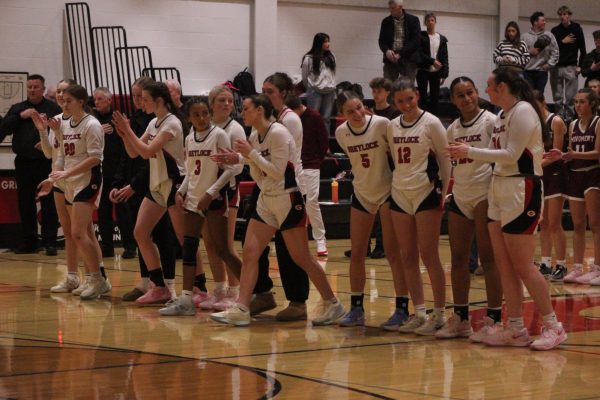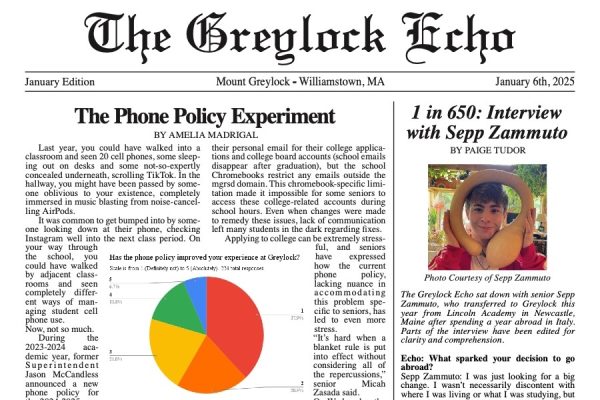A Look at Greylock’s New Safety Protocols
With the end of Thanksgiving break fast approaching, Mount Greylock will have completed nearly 8 successful weeks of hybrid learning, outlasting nearly every other school district in the county.
For months, various members of the Mount Greylock administration and staff as well as members of the community worked together to formulate the COVID-19 protocols for the initial shift from remote learning to hybrid back in October. The Echo took a deep dive into the guidelines Mount Greylock follows and the formation of the protocols we see in place today.
The district began to plan its course of action for reopening in the early days of July through the COVID-19 Reopening Wellness Group. Mount Greylock school nurse Nichole Russell said, “The members of the group consisted of a combination of the following professionals from Mount Greylock, and the two elementary schools: principals, vice principals, school nurses, school psychologists, guidance counselors, social workers, paraprofessionals and school physicians.”
The group met via Zoom once a week and followed a planned agenda with specific goals in mind. It was important for the group to make sure there were plenty of resources and support should the virus find its way into the Mount Greylock community. The overall safety and mental health of staff and students was their first priority.
From the beginning, the district had to abide by a variety of guidelines that are constantly changing even today. Mount Greylock Assistant Principal Colin Shebar said, “We have to follow federal guidelines coming from the CDC, there are state guidelines coming from the Massachusetts Department of Health, DESE (Department of Elementary and Secondary Education), guidelines from Berkshire County, working with the School Committee.”
One of the main metrics that was decided on before planning out the guidelines were the factors that could trigger a closure.
According to Shebar, the main reasons for a closure would be a yellow rating on the COVID-19 Massachusetts map which would be more than or equal to 25 cases for an area or a 3% positivity rate. The metrics used on the COVID-19 map have changed in the past few months to accommodate for small towns that were previously miscategorized and were misjudged on the scale that was used in the past.
The administrative body was then responsible for planning how students would function in the building. Shebar described the process as “trial and error,” as students weren’t actually in the building to test out various models.
Shebar said, “As far as desks, we had a couple of different setups in different classrooms around the building to figure out what is the best setup to maximize students while also following social distancing guidelines. We had to figure out how we should create walkways and access to doorways and abide by things like the fire code while also social distancing.”
Socially distant desks were not entirely possible given the current furniture the school possessed, so they had to introduce folding tv trays as tables in many cases. Some classrooms are designed in a combination of the regular desks and the tv trays, while the school foyer and cafeteria are set up with exclusively the trays.
The hallways were another issue for the school to figure out. One option, Shebar said, was “playing around with staggered transition times” in between classes so a limited number of students would be in the halls during passing periods. However, that posed the problem of kids waiting outside of classrooms before the previous class was dismissed.
Ultimately, the administration decided on dividing the hall in half with tape and using arrows for direction. Shebar said, “We figure it’s a system with supermarkets and stores that provides some guidance on how best to move through the halls.”
Another layer of protocols that have been introduced in regards toCOVID-19 is the health screener. Russell said, “Filling out the health screener helps to provide families and staff with the support they need to decide if they should or should not go to school that day.”
The screener is required to be filled out by a parent or guardian on days when students are planning on entering the building or if they plan on participating in an after school program on days they are remote. If a student’s health screener has not been completed, they will be denied entrance to the building until a guardian has filled out the health screener or can come pick them up and bring them home for the day. Also, if the guardian filling out the screener on behalf of the student indicates in any way that they are experiencing symptoms, the family will be advised by staff to stay home for the day.
Williamstown Elementary School Nurse Carol Stein-Payne said, “So many symptoms are so common (headache, nasal congestion, cough) that we might have ignored them in the past and came to school anyway. Now we have to be cautious.”
In the event that a student within the building presents with symptoms, they will be taken to a seperate medical waiting room to be evaluated by the nurse at that time.
Stein-Payne said, “I put on full personal protection equipment. I give the student a surgical mass, which is more protective than the typical cloth mask. They rest and relax while waiting for a parent to come pick them up. When their parents arrive, we explain that the student needs to see their MD for further evaluation and possible COVID testing, which is required for the student to return to school.”
The nurses have also been trying to minimize other types of visits to their offices. Stein-Payne made giant First Aid kits for each classroom given that recent protocols might not allow a student to come down to the office for safety reasons.
If a student needs medication, they are required to sanitize the room thoroughly and kids come at scheduled times to avoid any student overlap.
Transportation is another issue that has arisen in the midst of COVID-19 As Shebar said, “We have to follow the guidelines from the state on transportation on how to use buses.”
The buses now have a lower maximum capacity to ensure social distancing. If a student needs a late bus from the school, they cannot simply get on one as they have been able to in years past. Each week, students have to sign up for a spot on the late buses ahead of time.
The mask policy is the most specific of the new protocols. Following CDC guidelines on the most effective masks, students are only allowed to wear multi-layer cloth masks or surgical masks. Any other types, including buffs, are not allowed and any student seen wearing one will not be admitted into the building.
In the classroom, teachers were educated from the beginning on the new safety protocols the school was putting in place.
Russell said, “Professional development including staff training was also discussed in addition to exploring the ways we could branch out to ensure that education would be accessible to all students and their families.”
The staff was brought up to speed on the social distancing and mask policy, as well as the necessary cleaning that has to take place in between periods.
Russell said that the school, “provided COVID-19 focused education and training for all staff, including mitigation procedures, personal hygiene, signs and symptoms of illness, assessment, the referral process for students requiring mental health supports, and the use and disposal of health and safety supplies.”
The administration noted that it was really a collaborative process with the teachers that formed the guidelines for the school year. Shebar said, “We worked with the Mount Greylock Teacher’s Union to make sure we were attentive to everyone’s comfort level and it was truly a group effort as far as the planning process.”
Students have overall been happy with the guidelines put in place. Sophomore Sam Tucker-Smith said, “It’s honestly so much better than it could be. I think in classes, and in the halls the vast majority of the time, it feels really safe.”
However, some students have eluded to the need for fine tuning in certain protocol areas, especially when it comes to lunch. Freshman Erin Keating said, “The only complaint is lunch. We can only go outside to eat when it’s warm, and inside I don’t feel safe. Although we are socially distanced, we aren’t wearing masks and there are too many students in one room.”
Passing time has also become an issue. Other than the tape on the floor, there are not any other guidelines in place to ensure social distancing. Senior Mia VanDeurzen said, “We are all packed together in the halls at the same time.”
Additionally, the idea of the virtual hall pass has caused some chatter among students. Instead of the typical laminated hall passes students are familiar with, there is now an online system students use on their phones.
One major concern is uncertainty over how to request a pass from another teacher and the time limit on bathroom passes.
VanDeurzen said, “I think the virtual hall pass idea has caused a lot of anxiety for both students and teachers to figure out how to use it and it does feel like a violation of privacy.”
Despite some kinks in the system, students seem to be doing a good job. Junior Henry Art said, “The whole thing falls apart if someone gets sick, that’s just a consequence of our environment, but so far our kids have been really good about keeping themselves out of risk environments with the potential to get sick.”
With COVID cases on the rise, there is some concern over whether the school will remain open. Shebar said, “The feeder districts and towns for our school are doing well. People seem to be doing their part. We want to be respectful towards everyone’s needs and wishes. We had those two weeks at the beginning of the year before we began our hybrid schedule just to be prepared for this situation to ensure we could go back and forth between the different systems.” Shebar felt confident that we would be prepared for closure, but said, “We just aren’t there yet.”
To ensure that the school remains open, Stein-Payne advised families to stay safe during the upcoming holidays: “Now that the weather is getting colder and the holidays are here, it will be tempting to give in to the COVID fatigue we all feel and ignore the need to follow guidelines. We must be very strong in our conviction to protect ourselves, our families, and others around us by avoiding travel and staying with those in our household over the holidays.”
Even with the hope of a COVID vaccine coming as soon as early next year, the administration and nurses alike have stressed that it is imperative for students, staff and families to continue to follow the guidelines the school, town, and state have put in place to remain safe and keep schools open.



